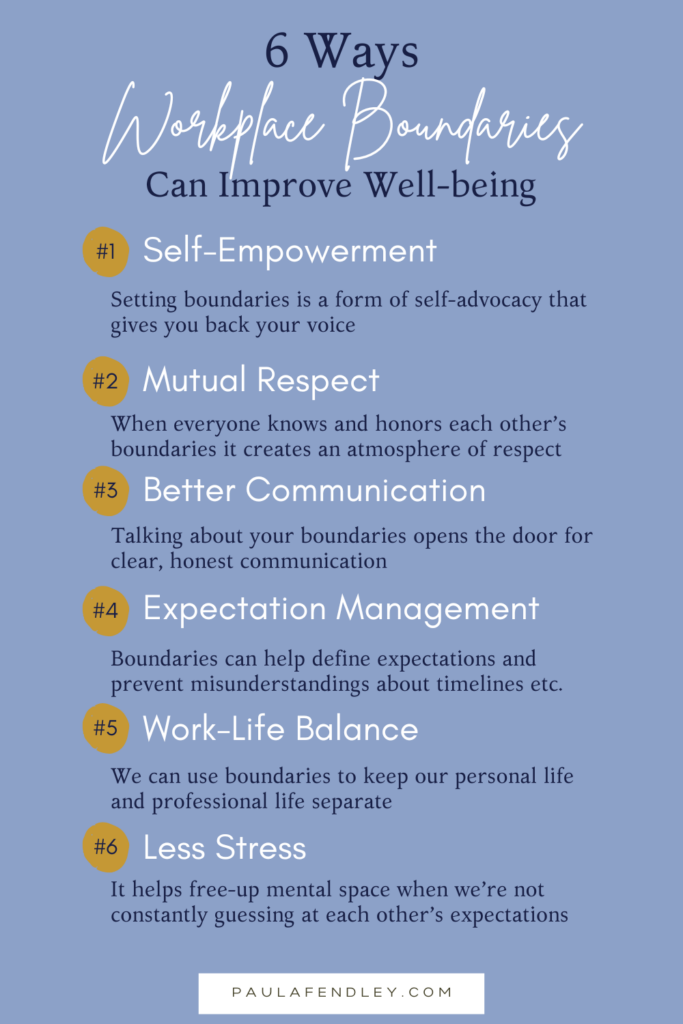In every workplace, from bustling corporate offices to work-from-home startups, boundaries are important. Personal boundaries are an absolute must for maintaining work-life balance, self-respect, and overall well-being. Whether you’re a seasoned executive or an ambitious new hire, understanding and implementing boundaries at work can significantly improve your experience at any job. This article will dive into the specifics of workplace boundaries, exploring their importance and practical strategies for setting and maintaining them effectively.
Jump To:
- Why are boundaries important in the workplace?
- Types of boundaries at work
- Time boundaries
- Communication boundaries
- How to set good boundaries at work
- Examples of unhealthy boundaries at work
- Final thoughts
Why are boundaries important in the workplace?
Workplace boundaries encourage respect, communication, and well-being. In every professional setting, boundaries are the invisible guidelines that shape interpersonal interactions and define expectations. Kelly Seibert, a Leadership and Self Advocacy Coach in Houston, TX, tells us that “Clear boundaries help everyone be effective and fulfilled without wasting energy.” Unclear or undefined boundaries leave colleagues feeling disrespected, misunderstood, overworked, and unappreciated.
Boundaries, or a lack thereof, play a crucial role in every work environment. From protecting personal time to inviting clear communication, boundaries can completely redefine work dynamics. Not only do healthy boundaries benefit individual employees at work, but their effect ripples into home lives and overall well-being.
Let’s explore six reasons why establishing clear boundaries is especially important in the modern workplace, according to Self Advocacy Coach Kelly.
Self-empowerment
Boundaries empower individuals to take control of their work environment and personal well-being. If you feel overworked, overwhelmed, unappreciated, or generally uncomfortable at work, chances are you haven’t defined clear boundaries yet. It’s all too common for workplaces to normalize bad behavior when the appropriate boundaries haven’t been established. By clearly defining limits and expectations, employees become free to advocate for themselves, increasing confidence and job satisfaction. This improved sense of self often translates into improved performance, making boundaries a win-win for everyone.
Mutual respect
Clear boundaries foster a culture of respect among team members. When everyone understands and honors each other’s needs and limits, it creates an atmosphere where considerate behavior is expected. A lack of boundaries leads to people feeling misunderstood and disrespected. Understanding each other’s boundaries within the work environment leads to stronger working relationships and reduced conflicts.
Good communication
Boundaries encourage open and honest communication. Coach Kelly says, “Setting a boundary doesn’t need to come across as harsh or unfriendly. When done well, boundary-setting can open the door for everyone to voice their needs and clear the air on misunderstandings.” When everyone at work feels comfortable expressing their needs and limits, it paves the way for more transparent and effective dialogue which helps everyone feel more fulfilled and effective.
Expectation management
By setting clear expectations, employees, managers, clients, and customers can get on the same page regarding workload, availability, timelines, etc. This clarity helps prevent overcommitment, reduces stress, and allows each contributing party to engage in more realistic goal-setting and project planning. It also minimizes the risk of disappointment or frustration due to unmet or unclear expectations. Coach Kelly goes so far as to say that “Oftentimes, people actually appreciate being explicitly told what your boundaries are because it allows them to adjust their own behavior accordingly. Then they can feel confident they’re doing the “right” thing.”
Work-life balance
Setting good time boundaries, which we’ll explain in more detail below, helps maintain a healthy work-life balance by clearly separating your work hours from personal time. This separation is crucial for mental health and helps avoid employee burnout. It’s important to feel safe and free to pursue personal interests and maintain relationships outside of work without worrying about how it will “interfere” with your productivity. A healthier work-life balance can lead to both increased job satisfaction and a more fulfilling home life.
Less stress
Well-defined boundaries can significantly reduce workplace stress. Poor boundaries leave everyone wasting energy trying to figure out what they’re supposed to be doing, how, and when. When everyone feels a sense of control over their own work environment and responsibilities, they’re better equipped to handle challenges when they arise. Healthy workplace boundaries can lower organizational stress levels and free up mental energy that employees could spend on producing their best work.

Types of boundaries at work
Clear boundaries in the workplace are essential for maintaining an atmosphere of professionalism, productivity, and self-advocacy. Still, there are two types of boundaries that are frequently crossed (or perhaps never discussed) in work environments: time boundaries and communication boundaries. Even if these boundaries are being crossed unintentionally, the breach can lead to discomfort, stress, overwhelm, poor performance, conflicts, and even burnout.
Time Boundaries
In our modern world where cultural norms idolize the grind,” and a “work now, play later” mindset, it’s easy for time boundaries to be overlooked or dismissed. This type of boundary includes defining office hours, expectations of availability and responsiveness, personal time, and the separation between professional and personal life.
Here are some common ways that time boundaries tend to get crossed at work:
Expectations of constant availability
Overtime without compensation
Skipping coffee breaks, lunch, or personal days
Vacation time interruptions
Communication Boundaries
Communication boundaries define how and when colleagues interact with each other. Although many of us feel wary about striking up difficult conversations, setting up good communication boundaries actually helps improve communication over time.
Communication boundaries are often crossed in these ways:
Disrespectful or belittling language from higher-ups
Too much/distracting communication throughout the workday
Disregard for preferred communication methods and times
Oversharing personal information
Inappropriate topics
Excessive non-work-related chatter
Lack of respect for focus time
How to set good boundaries at work
Determine your own needs
Setting good boundaries at work will look a little bit different for everyone. Coach Kelly emphasizes that the right boundaries for you are based on first noticing your personal feelings and needs. To set effective boundaries, start by asking yourself: “How do I feel?” and “What do I need?” Reflect on situations that cause stress or discomfort and identify areas where boundaries are necessary. Consider your personal values, work style, and long-term career goals when determining your limits.
Shift your mindset
The first step in setting good boundaries is shifting your mindset to understand that clear boundaries benefit everyone involved. Coach Kelly says that for many people, one of the most challenging aspects of setting boundaries is overcoming the belief that they are an annoyance or hindrance to others. “In reality,” she continues, “boundaries establish a safer, more productive environment for everyone.” When everyone understands the rules and expectations of a situation, they can adjust their plans and behavior accordingly. The negative impact of having no clear boundaries in place is that everyone is left to wonder why things aren’t going their way, why communication is strained, and what they could have done differently.
Remember that setting boundaries is not selfish; it’s a crucial step in creating a healthier work environment for yourself and your colleagues.
Define your internal boundary
Before tackling scary conversations with your colleagues, the most important thing you can do to establish better boundaries is to determine what you can do differently. Coach Kelly goes so far as to say that “sometimes setting an internal boundary turns out to be all we really need to completely change the way a situation feels.” The Harvard Business Review cites neglecting this step as one of the major reasons boundaries fail – we ask others to change before we change ourselves. Coach Kelly goes on to clarify, “This doesn’t mean all of the burden or responsibility is on you–but it does start with you. Internal boundaries will make it much clearer what kind of boundaries you need to set with others, OR they might just send the message to that person before you even need to have a tricky conversation.”
Before addressing external factors, focus on how your actions, beliefs, and attitudes might be contributing to the problem. What can you change internally? How can you change your perspective? What boundaries can you create for yourself that would help distance you from the thing that’s making you uncomfortable? You may consider implementing time-blocking techniques or automated responses during certain hours to manage your own workflow more effectively. Setting specific personal goals like using more sick days or keeping better notes can also be a form of setting internal boundaries. Whatever your internal boundaries are, it’s important that you be consistent with them before you can expect any external boundaries to stick.
Define your external boundary
Once you’ve established your internal boundaries and you’ve determined what additional changes need to be made, it’s time to communicate your needs to others. If you’re setting new time boundaries, let your colleagues know when you’ll be available, what to do if they have an urgent matter, and what does and doesn’t constitute “urgent.” Set them (and yourself) up for success by providing guidelines on how to respect your new boundaries. An example, Coach Kelly says, would be letting them know, “I’ll be checking my work email between 9-10 AM and 4-5 PM daily. For urgent matters outside these times, please call my office number. Anything that doesn’t need my attention by EOD is not considered urgent.” External boundaries could also look like establishing expectations for meeting schedules and durations, defining roles and responsibilities within a team, or creating physical boundaries that increase privacy.
Be consistent
Consistency is an important part of creating new boundaries. Consistently adhering to your internal boundaries and staying firm with your external boundaries is the best way to reinforce that your established limits are here to stay. Your consistency will help encourage a culture of respect for personal and professional boundaries within your team. Coach Kelly says that this step is where many people find value in enlisting the help of someone like her. She says, “A good coach can help you stay consistent with your boundaries and be your teammate while you navigate potentially tense conversations and advocate for your needs.”
Check-in with yourself regularly
In order for your boundaries to remain effective long term, it’s important to periodically check-in with yourself to make sure what you’re doing is still working. The ultimate goal of setting boundaries is to improve how you feel. Sometimes it takes a little trial and error to discover what external changes will really lead to the internal peace you’re looking for. Ask yourself, “Am I feeling better and more in control?” If not, you may need to adjust your internal or external boundaries to better align with your goals and needs.
Examples of unhealthy boundaries at work
We asked Coach Kelly to give a few examples of unhealthy boundaries she’s helped her clients overcome in their workplaces. Here are some of the most common examples of unhealthy boundaries she’s seen.
Example #1:
Receiving emails at any moment and dropping everything else, even an important task, to attend to them.
Coach Kelly says, “A healthy alternative would be time-blocking specific times when you’ll check and respond to emails so you can focus on and be more productive with your other work”
Example #2:
Regularly working long hours or on weekends to complete tasks because it feels like everyone expects you to get things done within a few days.
Coach Kelly says, “In reality, this is just reinforcing people’s unrealistic expectations of what you can comfortably accomplish. Plus, it labels you as the go-to person in the office for last minute projects when your colleagues procrastinate or fail to plan correctly. Define your work hours and communicate realistic deadlines for projects. Let your colleagues know that you are not a machine and you will no longer be taking on extra work during your free time to get their tasks done.”
Example #3
Taking on additional work beyond your job description without compensation or recognition.
“Learning to say ‘no’ is a skill that many people need more practice with,” says Coach Kelly. “It’s important to remember that long term, taking on work outside of your job description will lead to resentment and burnout. Although it may feel like you’re just trying to be a team player now, you’re hurting yourself and your company in the long run. If it’s additional work that you genuinely enjoy or learn from, make sure you ask for the recognition you deserve for doing that work.”
Final Thoughts
Setting and maintaining clear boundaries in the workplace is crucial for creating a healthy work environment, preventing burnout, and fostering positive professional relationships. By defining your own boundaries, you can take control of your work life and improve your overall well-being. Remember that boundary-setting is an ongoing process that may require adjustments over time. Shifts in your needs, your position, and your workplace culture are all invitations to re-examine your boundaries. With practice and consistency, you’ll find that well-defined boundaries can improve your professional life immensely.
If you’d like support in setting better workplace boundaries, you may consider hiring a Self Advocacy Coach like Kelly, who can help you confidently create a healthier, happier work environment

